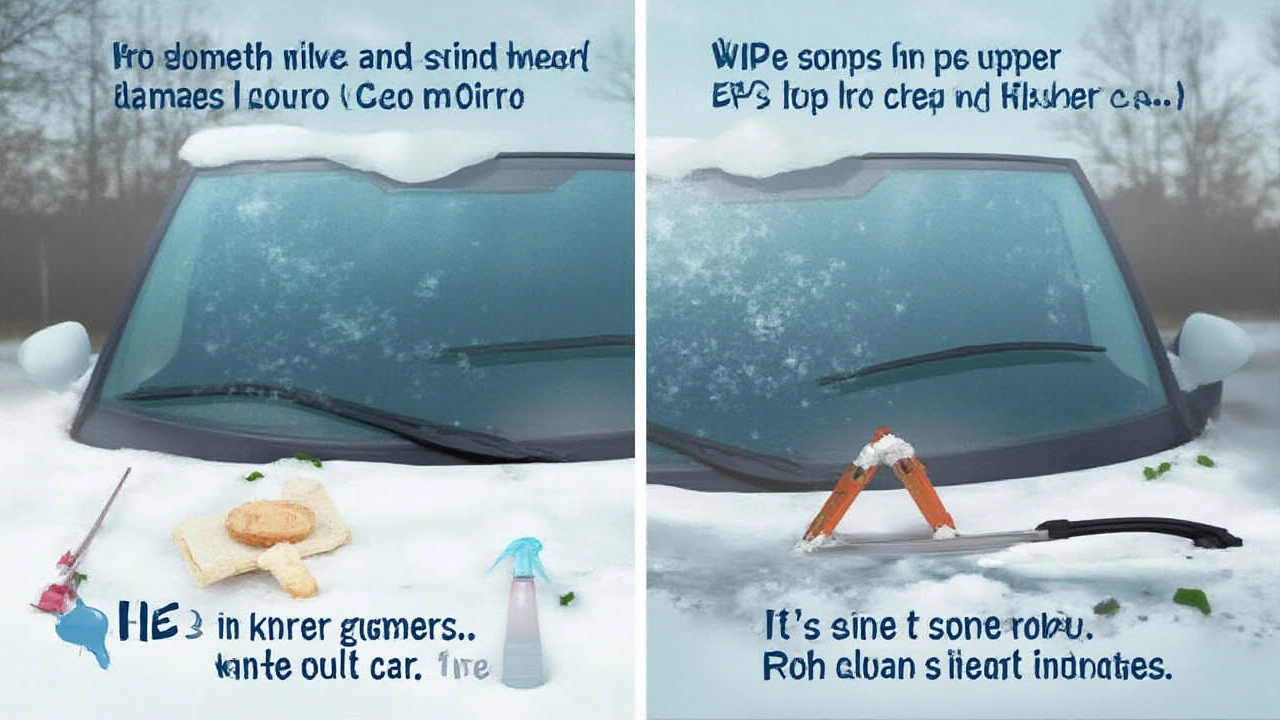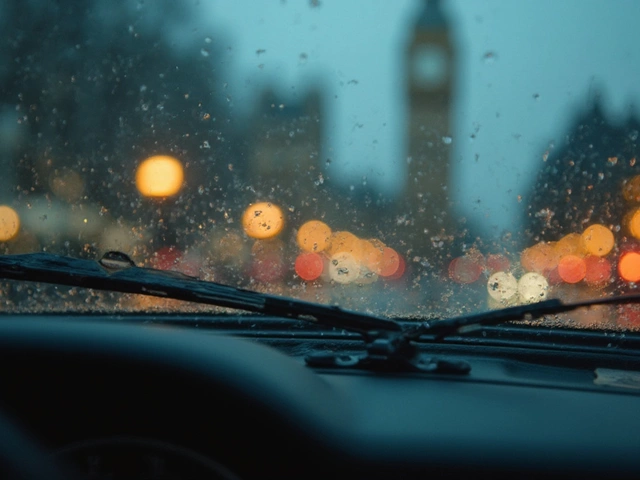You’re walking through a frosty morning in Manchester, and there they are—rows of parked cars, their windscreen wipers poking proudly upwards. It looks a bit odd at first, almost as if the cars are waving their arms in sleepy protest at the chill. But this odd sight isn’t just neighborhood quirkiness. Leaving wipers up is a trick drivers use from Canada to Scandinavia—and for good reason.
The Real Reasons People Leave Their Wipers Up
It’s not just about dodging frozen wipers. Most folks pop their wipers upright before an icy night to prevent the blades from sticking to the glass. When a car sits through frost or snow, the rubber can freeze solid onto the windscreen. Next morning, you hop in, click the wipers—and if they’re stuck, the motor could snap the blade or even burn out. No one wants to replace a wiper motor because of a bit of laziness.
In the UK, we get our share of cold snaps, but the “wipers up” habit is massive in colder countries. Scandinavian drivers, for example, see winter temps dropping to -20°C, and a stuck wiper will literally tear. Manchester rarely sees such extremes, but anyone with an early commute knows the pain of battling frost at 6 a.m. And it’s not just ice. Wet snow and freezing rain can glue wiper blades as firmly as a builder’s adhesive. A torn blade is rubbish at cleaning your windscreen and can scratch the surface if you force it.
You also get another perk: leaving the wipers up makes it easier to scrape away car ice or snow with both hands free. Ever tried scraping your windscreen with the wipers still down and in the way? Annoying, right? By flipping up the blades, you save time and avoid smacking the wiper against the scraper, which can damage both.
This trick isn’t only about cold climates. Ever notice dusty, pollen-filled springs or sandstorms? Lifting the wipers stops gunk building up in the rubber—especially useful where tree sap and bird droppings are a threat. The less the blade sits flat, the less likely the edge is to dry out, warp, or snap.
But let’s bust a myth. Some folks reckon putting the wipers up saves the springs—not true. The spring in the wiper arm is meant to keep steady pressure for a clean swipe. Leaving it stretched by being upright might weaken the force slightly over a decade or two, but by then most cars are long gone to the scrapyard. In reality, the risks of frost outweigh any minor concern over spring tension.
Here’s an interesting stat about wiper damage: RAC data suggests nearly 20% of British drivers have damaged their wipers by using them to clear ice or heavy frost. A quick flip upwards overnight could’ve saved them the hassle and a trip to Halfords in the cold.
| Country | Average Winter Low (°C) | Wipers Up Common? |
|---|---|---|
| UK (Manchester) | 0°C | Sometimes |
| Canada (Toronto) | -7°C | Very Common |
| Finland (Helsinki) | -5°C | Extremely Common |
| USA (Minnesota) | -11°C | Very Common |
| Australia (Sydney) | 7°C | Rare |
Urban myth also says lifting the wipers can somehow stop the rubber perishing in sun, but sunlight exposure is about your parking habits, not your wipers. Parking under cover does more to protect the blade than keeping it upright. Plus, UK sun is hardly fierce enough to melt much anyway—Manchester averages just 1,400 hours of sun a year.

Wipers Up: When It’s Smart, and When It’s a Silly Move
Right, so the main time to lift the wipers is before a frost or heavy snow. But it’s not a one-size-fits-all trick. If there’s no cold weather coming, there’s not much benefit. In fact, in windy storms, a wiper sticking up is more likely to get bent out of shape if blown about. And if vandals are about, an upright wiper is easy pickings for a quick snap—so don’t give them an invitation.
Some cars make it easy to lift the wipers. On many modern vehicles, the blades rest under the edge of the bonnet, protected from the elements. You’ll need to switch off the ignition, then flick the wipers up using a service mode from the stalk. Toyota, VW, Volvo… loads of makes use this design now. It means the days of just grabbing and yanking up the blade are slowly fading. Always check the manual before you try to force your wipers up—breaking a modern arm is a pricey error.
Here’s another quirky tip: after freezing rain, hot water might seem like a smart thawing move. Don’t do it. Pouring warm water onto frozen glass can crack the windscreen instantly. It’s not just a myth—Autoglass repairers see over a hundred cases of “thermal shock” every cold season, where keen drivers have ruined their windscreens in seconds. Instead, a simple aerosol de-icer or just the engine heater is much safer.
Have you spotted cars with actual wiper covers—or even people wrapping theirs with socks? That’s another prevention hack. Some swear by popping an old sock or bit of bubble wrap over the blade. It looks strange, but protects the rubber from hard freezes and reduces the scrape needed to free it.
Then there’s the point about worn wipers. Most people only think about wipers during rain or snow, but did you know a typical British wiper does up to a million wipes each year? That’s a lot of work. Leaving a blade welded to ice is just asking for a tear or split, turning every rainy drive into a blurry chore.
If you park outside, and especially if the car’s not moving for a few days, the wipers-up trick is even more useful. The more time a blade sits on damp glass, the more chance it sticks—particularly with older rubber that’s lost its “spring.” Some drivers deliberately add a fine layer of talc or a little silicone spray to keep the blades supple, especially before a holiday trip away when the car won’t move for a week.
Don’t forget about rural risks, either—saps and bird droppings. In spring, trees beach their pollen and sticky resin everywhere. A sticky wiper rubber can attract muck like nothing else, and it’s easier to wash both separately if the blades are up. Just watch out for the wind blowing the wipers over if it gets gusty. In especially windy or stormy areas, popping them up may mean coming back to a slightly bent arm. Not ideal.
And about safety: if there’s a big freeze overnight, you might be tempted to clean your windscreen with the wipers as soon as you get in. But ice is abrasive—every pass can scratch the glass and dull the rubber edge. By leaving them up, and defrosting the glass first, you let the blades last longer and keep the windscreen clearer in the long run.
- Don’t lift the wipers unless you expect a heavy frost, snow, or lots of sap/pollen—the risk of bending them in stormy weather isn’t worth it otherwise.
- If your car has “service mode” for the wipers, use it—forcing them up otherwise can break a hidden latch or spring.
- Avoid pouring hot water on icy glass—it’s a recipe for disaster and broken windscreens.
- Try wiper socks or covers during harsh cold snaps—they look goofy but work wonders.
- Always clear heavy snow from around the blades before using them—wedging them up is only half the battle.

Best Practices for Wipers: Making Yours Last Longer
Ask any mechanic: most wiper problems can be avoided if you look after them properly. The best hack for blade longevity isn’t just leaving them up—it’s proper maintenance. Clean the rubber with a damp cloth or alcohol wipe every couple of weeks, particularly after storms or tree-shedding season.
Never use the wipers on a dry or dusty window. It scrapes grit across the rubber edge, scratching both blade and glass. If you need to clear a dusty windscreen, always use washer fluid first to wet the surface. For folks in Manchester and other damp cities, that’s basic—but in arid areas or after roadworks, it’s a lifesaver for the blades.
Replace your wipers at least once a year, or when you see smearing or streaks. Don’t wait until you can barely see through the glass. A new set costs less than two rounds at the pub and is far cheaper than a scratched windscreen or failed MOT.
Here’s how to make the most of the wipers-up trick, step-by-step:
- Check the overnight forecast for frost or snow.
- Pop the wipers up (gently!) before you lock up for the night. If your car has a service mode, use it.
- If you’re feeling enthusiastic, slide a sock or cover over the blade.
- Use a proper ice scraper in the morning, not the wipers. Wait until all the ice is gone before laying them down.
- Give the blades a quick wipedown with washer fluid or a damp cloth post-defrosting.
Want to geek out? The UK’s legal minimum for a car’s field of vision is about 98%, according to DVSA rules. If your wipers leave even a centimeter of unwiped ice, you could technically get a fine. While the police aren’t likely to chase you down for a bit of missed frost, any accident caused by poor visibility is a different story. And that’s a headache nobody needs.
There’s chatter about “smart wipers” that retract into the bonnet or heat up to melt ice—luxury models already come fitted with heated windscreen elements precisely for this reason. In these cases, you don’t need to leave the blades up—the car does the work for you. That’s progress for you, but for everyone with a trusty Fiesta or Astra, old tricks do the job just fine.
If you’ve ever lived somewhere with truly brutal winters, you’ll know drivers go further: commercial drivers even bring wiper arms indoors, fitting them at the start of every shift. It’s overkill for most, but for lorry drivers in Norway or Poland, it’s just another day on the job. The rest of us can usually get by with a quick flick and a cheap cover.
The bottom line? Leaving your wipers up is an old-school tip that still works. It won’t solve every weather problem, but for a few seconds’ effort, it can save you the hassle of wrecked blades, scratched glass, MOT fails, or worse—a totally blocked view. Doesn’t matter if you’re driving a battered old Micra or a shiny new Golf, it pays to give your wipers a little respect.
Next time the clouds close in and the temperature plummets, join the locals—and let your car salute the weather with those wipers up. Your windscreen (and wallet) will thank you for it.


